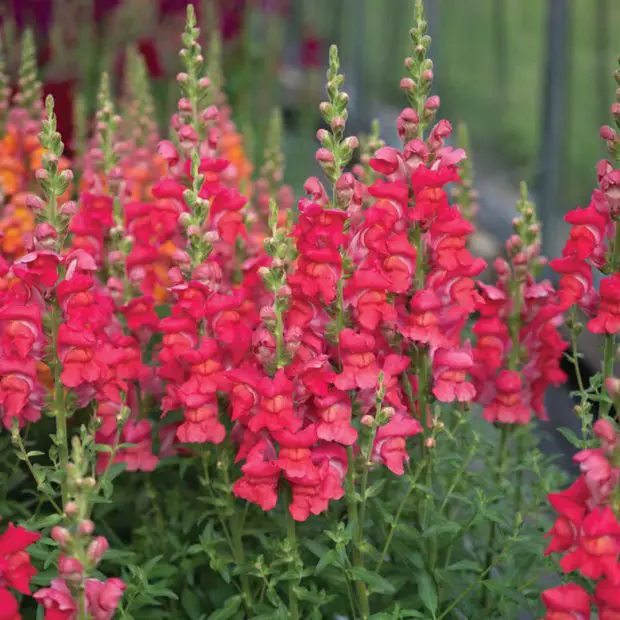Snapdragons (Antirrhinum majus) are one of the most beloved cool-season flowers in temperate gardens across the United States. With their tall spires, ruffled petals, and vibrant colors ranging from pastel pinks to fiery reds and bold purples, snapdragons add drama and texture to both spring and fall landscapes. Gardeners prize them not only for their aesthetic appeal but also for their versatility—they perform well in borders, containers, and as cut flowers.
Knowing exactly when to plant snapdragons is the key to ensuring a continuous bloom cycle in spring and a dramatic resurgence in fall. Because snapdragons prefer cooler temperatures for germination and flowering, timing is everything.
The Life Cycle and Growth Requirements of Snapdragons

Snapdragons (Antirrhinum majus) follow a cool-season growth cycle that makes them distinct from many other annuals commonly grown in the U.S. Their life cycle begins with seed germination, followed by vegetative growth, bud formation, blooming, and eventual seed set. Depending on your planting time and local climate, snapdragons can either complete this cycle in one season or extend into a second bloom period, particularly in zones with mild winters.
The seeds require light to germinate and must be sown on the soil surface or gently pressed in without being buried. Under optimal conditions—temperatures between 60°F and 70°F with bright indirect light—germination typically occurs within 7 to 14 days. Early growth is slow, and seedlings are highly sensitive to low light, which can lead to legginess if not provided with strong overhead lighting or sufficient outdoor sun exposure.
Once established, snapdragons thrive in daytime temperatures ranging from 60°F to 75°F. They tolerate light frosts and prefer cool nights, making them ideal for early spring or fall planting. While they can withstand brief cold snaps, extended exposure to hard freezes may damage or kill immature plants, especially in zones below USDA 6.
As temperatures rise into the 80s and beyond, snapdragons often slow their bloom production or go into partial dormancy. Some varieties will persist through summer in cooler microclimates if well-maintained with deadheading and shading, but most perform best when grown as part of the cool-season planting cycle. In zones 8–10, snapdragons may overwinter and return in spring, completing a biennial-like pattern.
Snapdragons are moderate feeders and grow best in fertile, well-drained soil rich in organic matter. They need consistent moisture during establishment but dislike overly wet roots. Strong air circulation and spacing between plants help prevent common fungal diseases, especially during humid weather.
By aligning your planting schedule with their natural cool-weather preferences and giving them the right start, snapdragons can flourish in both spring and fall gardens—bringing structure, texture, and vibrant color to any landscape.
Choosing the Right Planting Season: Spring vs. Fall
Selecting the optimal planting season for snapdragons depends on your regional climate, USDA hardiness zone, and the specific performance goals you have for your garden. Since snapdragons are cool-season annuals (or short-lived perennials in warm zones), they can be successfully grown in both spring and fall—each with distinct advantages and challenges.
Spring Planting: Ideal for Early Season Color
Spring is the most common season for growing snapdragons, especially in cooler climates. In USDA zones 3 through 7, where winters are harsh and frost persists into March or April, spring planting allows gardeners to take advantage of the cool temperatures snapdragons thrive in without risking cold damage to young transplants. Gardeners in these regions often start seeds indoors 10 to 12 weeks before the last expected frost date and transplant hardened-off seedlings outdoors once daytime temperatures remain consistently above 50°F and danger of deep frost has passed.
The benefit of spring planting is an early burst of blooms that can last well into early summer in mild climates. However, in regions with rapidly rising spring temperatures, snapdragons may enter dormancy or decline as early as June. To extend their bloom season, gardeners can choose heat-tolerant varieties and use mulch or light afternoon shade.
Fall Planting: Extending Color into Cooler Months
Fall planting is ideal in USDA zones 8 through 10, where winters are mild and frost is infrequent or short-lived. In these regions, snapdragons planted in late summer to early fall (typically August through October) will establish strong root systems during cooler autumn nights and begin blooming as temperatures drop. With proper care, these plants can continue flowering well into late fall and sometimes even through winter, bouncing back with renewed vigor in early spring.
Fall planting offers the advantage of fewer pests, cooler soil temperatures for root development, and often longer bloom durations. However, timing is critical—plants need several weeks to establish before the first expected frost. In zones where winters are borderline, using mulch or frost protection will help overwinter snapdragons successfully.
Ultimately, choosing between spring and fall depends on your zone and garden goals. Many gardeners in temperate zones plant snapdragons in both seasons, enjoying two flushes of color—once as the first signs of spring emerge, and again as summer fades into a cooler, more vibrant autumn.
Understanding Your Growing Zone
Planting snapdragons at the right time begins with a clear understanding of your USDA hardiness zone. These zones, based on average annual minimum winter temperatures, help gardeners determine the appropriate planting window and seasonal strategies for their specific region.
What USDA Zones Reveal About Your Climate
The USDA hardiness zone map divides North America into 13 main zones, each representing a 10°F range of average minimum temperatures. Snapdragons, being cool-season flowers, thrive best in cooler conditions and have a moderate tolerance for light frost. Knowing your zone helps you predict your region’s last spring frost and first fall frost—two critical factors in scheduling snapdragon planting for maximum bloom potential.
For example, gardeners in zone 5 must contend with late spring frosts and early autumn freezes, meaning snapdragons are typically spring-planted and treated as annuals. In contrast, those in zone 9 or 10 enjoy longer cool seasons, allowing for fall planting and even overwintering.
How Snapdragons Behave in Different Zones
Snapdragons are generally hardy in USDA zones 7–10, where they can be grown as short-lived perennials or seasonally persistent annuals. In colder zones (3–6), they are strictly grown as annuals due to their limited tolerance for hard freezes.
Zones 3–5: Snapdragons must be started indoors early and transplanted after the last frost. Fall planting is not feasible due to early winters.
Zones 6–7: Both spring and early fall plantings are possible, but spring offers more predictability. Fall-planted snapdragons need protection if overwintering is attempted.
Zones 8–10: These warmer zones support both fall and spring planting. Fall-planted snapdragons often perform better due to milder winters and longer bloom windows.
Frost Dates and Timing Your Planting Window
In all zones, the two most useful dates to know are your average last frost date in spring and first frost date in fall. Snapdragons can handle light frost but need time to establish roots before harsh cold or summer heat sets in.
Spring planting should occur 4–6 weeks before the last expected frost if starting with transplants. Fall planting should take place at least 6–8 weeks before the first expected frost, allowing the plants to develop roots while temperatures are still favorable.
Understanding how your specific zone influences snapdragon growth ensures you’ll choose the right planting time for optimal performance and prolonged color throughout the season.
Starting Snapdragons from Seed Indoors
Growing snapdragons from seed indoors allows gardeners to control the environment during the most delicate phase of the plant’s development. This method is especially useful in colder climates or for those seeking earlier spring blooms, as it gives snapdragons a strong start before they face outdoor conditions.
Best Time to Sow Snapdragon Seeds Indoors
Timing is crucial when starting snapdragons indoors. Seeds should be sown 10 to 12 weeks before your region’s average last frost date. For many gardeners in temperate climates, this means starting seeds between late December and early February. Beginning early ensures that plants are large and robust enough for transplanting when the weather warms.
Snapdragon seeds have a relatively long germination and maturation period compared to other annuals. Early sowing gives them enough time to establish strong root systems and develop multiple sets of leaves before moving outdoors.
Ideal Conditions for Germination and Growth
Snapdragon seeds require light to germinate, so they should not be covered with soil. Instead, sow them on the surface of a sterile, well-draining seed-starting mix and gently press them down to ensure contact with the medium. Maintain a consistent temperature of around 65°F to 70°F using a heat mat if necessary. Under these conditions, germination typically occurs within 7 to 14 days.
Once the seeds sprout, they need bright, direct light for 12 to 16 hours daily. Without sufficient light, seedlings may become leggy and weak. A sunny south-facing window may be adequate, but most growers prefer using grow lights placed just a few inches above the seedlings to promote sturdy growth.
During this phase, it is important to maintain moderate moisture levels. The growing medium should remain consistently damp but never soggy. Overwatering can quickly lead to fungal diseases like damping-off, which is fatal to young seedlings.
Thinning and Transplanting Seedlings to Larger Cells
As seedlings develop their first set of true leaves, it’s time to thin them by snipping weaker sprouts at the base, leaving the healthiest one per cell or pot. When roots begin to fill the growing container or plants have several sets of true leaves, they should be moved into slightly larger pots to continue growing until transplant time.
Providing a small amount of diluted liquid fertilizer at this stage—once every 10 to 14 days—can encourage strong root and leaf development. Avoid overfeeding, as snapdragons are sensitive to excessive nitrogen, which can result in weak stems or reduced flower production later.
Hardening Off Before Outdoor Transplanting
Before planting snapdragons outdoors, it’s essential to harden them off. This process involves gradually exposing the young plants to outdoor conditions over a 7 to 10-day period. Begin by placing them in a sheltered, shaded location for a few hours per day, gradually increasing their exposure to sunlight, wind, and fluctuating temperatures.
Skipping or rushing this step often leads to transplant shock, which can set back growth or result in plant failure. Once hardened off and the outdoor temperatures remain consistently above freezing—especially at night—seedlings can be safely transplanted into garden beds or containers.
Starting snapdragons from seed indoors requires attention to detail and time, but the reward is healthy, vigorous plants that bloom earlier and longer than store-bought starts. This method also opens up access to a wider range of unique snapdragon varieties not commonly found in nurseries.
Direct Sowing Snapdragons Outdoors
Transplanting Nursery Starts
Transplanting snapdragon starts from nurseries is a reliable way to get a head start on blooms without the effort of seed starting. Proper timing, soil prep, and early care are key to success.
Best Time to Transplant
In cooler zones (3 to 7), transplant snapdragons two to three weeks before the last expected frost. They handle light frosts well, so early planting helps roots settle before heat arrives. In warmer zones (8 to 10), transplant in early fall or late winter for strong seasonal color. Avoid planting during cold snaps or hot spells, and aim for cloudy days or cooler parts of the day.
Preparing Soil and Seedlings
Use rich, well-draining soil with a pH between 6.0 and 7.0. Work compost into the top layer to improve structure and fertility. Water seedlings in their containers before removing them. Gently slide out the root ball without damaging the stem and plant at the same depth they grew in the pot. Water well to settle the soil and reduce shock.
Spacing and Placement
Space plants according to type: dwarfs need 6 to 8 inches, tall varieties 10 to 12 inches. Good spacing supports airflow and reduces disease risk. Snapdragons need full sun for best flowering. In containers, use a loose potting mix and ensure drainage.
Keep soil evenly moist in the first two weeks, then feed with a balanced fertilizer to support strong growth. With the right start, nursery snapdragons adapt quickly and bloom reliably through spring or fall.
Snapdragon Planting Strategies
To cultivate a vibrant and long-lasting snapdragon display, gardeners must apply thoughtful planting strategies tailored to local conditions, seasonal timing, and plant variety. Whether you start from seed or purchase transplants, the success of your snapdragon bed hinges on proper site selection, soil preparation, and spacing.
Planning Based on Climate and Bloom Goals
In regions with cold winters, snapdragons are best treated as cool-season annuals, planted in early spring for blooms that last until midsummer. In contrast, mild-winter zones allow for fall planting, which gives the plants time to develop strong root systems and results in earlier, more robust spring flowering.
If your goal is to enjoy snapdragons throughout both spring and fall, stagger plantings by several weeks. This succession approach ensures a continual wave of blooms and extends the season well into early summer or even fall, especially when combined with deadheading and regular maintenance.
Optimizing Soil and Site Conditions
Snapdragons thrive in nutrient-rich, well-drained soil that retains moisture without becoming waterlogged. Sandy loam with added compost or well-rotted manure offers the ideal base for growth. If your native soil is heavy clay or extremely sandy, consider raised beds or amend with organic matter to improve structure.
Choose a planting site that receives at least six hours of direct sunlight each day. While snapdragons can tolerate light afternoon shade, full sun promotes stronger stems, more blooms, and better resistance to fungal issues.
Coordinating Spacing for Airflow and Visual Impact
Plant snapdragons with enough space to promote airflow between plants, especially in humid climates where fungal diseases can take hold. Shorter varieties can be planted more densely, while taller types benefit from wider spacing to prevent crowding and flopping.
For visual interest, mix varieties of different heights and colors within your beds or containers. Place taller snapdragons toward the back of garden borders or as a central focal point in containers, with mid-height and dwarf types filling in the foreground. This layered strategy adds depth and ensures all plants receive adequate light and airflow.
By aligning your planting methods with seasonal timing, climate realities, and soil readiness, you create the foundation for a healthy, thriving snapdragon display that brings vibrant color to your garden across multiple seasons.
Growing Snapdragons as Cool-Season Annuals
Snapdragons perform exceptionally well as cool-season annuals in many parts of the United States. These hardy plants thrive in the mild temperatures of spring and fall, making them ideal for early-season color and late-season interest when many other flowers begin to fade.
Understanding Cool-Season Behavior
Unlike many warm-season flowers, snapdragons prefer temperatures between 55°F and 75°F. They grow best when days are cool and nights are still a bit chilly. This makes them an excellent choice for planting in early spring as soon as the soil is workable, or in late summer to early fall when the worst heat has passed.
As cool-season annuals, snapdragons often bloom continuously from mid-spring into early summer, or from mid-fall until the first hard frost, depending on when they’re planted. In regions with long cool seasons, they can persist for months, offering sustained color with minimal care.
Geographic Suitability and Seasonal Timing
In USDA zones 3 to 7, gardeners should treat snapdragons strictly as spring annuals. Start seeds indoors 8 to 10 weeks before the last frost or purchase nursery transplants and set them out two to three weeks before the average last frost date. These cool-season conditions support rapid root development and strong early growth before the heat of summer sets in.
In zones 8 to 10, snapdragons can be planted in fall and grown through winter into spring. The mild winters in these zones provide ideal conditions for overwintering plants, leading to earlier, fuller blooms once the days start to warm in late winter or early spring.
Maintenance for Continued Bloom
To maximize blooming during the cool season, provide consistent watering, ensuring the soil stays moist but not soggy. Apply a balanced fertilizer every 4 to 6 weeks to maintain energy for flower production. Deadheading spent blooms regularly encourages more buds and prevents the plant from setting seed too early.
Although snapdragons are not frost-tender, hard freezes can damage the upper foliage. Applying a light mulch in late fall helps protect roots in borderline zones and extends the plant’s productivity.
With proper timing, care, and understanding of seasonal needs, snapdragons grown as cool-season annuals bring vibrant life to your garden when few other flowers dare to bloom.
Overwintering Snapdragons for Repeat Blooms
Snapdragons are often grown as annuals, but in suitable climates and with proper techniques, they can successfully overwinter and return with vigorous blooms in the following season. Overwintering snapdragons offers gardeners an economical and efficient way to enjoy earlier flowering without restarting from seed or transplanting new seedlings each year.
Conditions Required for Successful Overwintering
To survive winter, snapdragons need protection from severe frost and prolonged freezing. In USDA hardiness zones 7 and above, particularly zones 8 to 10, snapdragons can overwinter naturally outdoors. These areas experience mild winters with only light frosts, which snapdragons can tolerate if they are healthy and well-established.
In colder regions (zones 6 and below), overwintering outdoors is risky unless there’s significant winter protection. Freezing temperatures may kill the plant back to the roots or entirely if no insulation is provided.
Key factors for overwintering success include planting in well-drained soil, reducing nitrogen-heavy fertilization late in the season, and maintaining strong root development before frost. Healthy, established plants have a much better chance of surviving dormancy.
Outdoor Protection Techniques
Mulching is a critical step in helping snapdragons survive the winter. After the first light frost, apply a thick layer of organic mulch—such as straw, shredded leaves, or pine needles—around the base of the plant. This helps insulate the roots and buffer against temperature fluctuations.
You should also cut back tall stems by about one-third to prevent wind or cold damage. Avoid heavy pruning that can stress the plant before winter sets in. In particularly harsh winters, using a cold frame, garden cloche, or frost blanket can add an extra layer of protection, especially during sudden deep freezes.
Indoor Overwintering Options
In regions where outdoor overwintering is not practical, snapdragons can be dug up and overwintered indoors. Before the ground freezes, carefully lift the plants and pot them in containers with well-draining soil. Place the pots in a cool, bright area like an unheated sunroom, enclosed porch, or cold greenhouse where temperatures remain between 40°F and 55°F.
Keep the soil barely moist to prevent root rot, and avoid fertilizing until early spring. While the plant may not continue blooming indoors, it will conserve energy and resume active growth once returned outdoors when conditions improve.
Benefits of Overwintered Plants
Overwintered snapdragons typically bloom earlier and more vigorously in spring compared to new plantings. These mature plants already have established root systems, allowing them to focus energy on flower production rather than root development. In some cases, overwintered snapdragons also grow larger and produce more blooms throughout the season.
By learning to overwinter snapdragons effectively—either in place or indoors—gardeners can take full advantage of the plant’s resilience and enjoy a longer, more rewarding bloom cycle year after year.
Companion Planting and Garden Design Ideas
Common Mistakes to Avoid When Planting Snapdragons
Snapdragons are generally easy to grow, but common mistakes can limit their vigor and shorten their bloom period. One major issue is planting too late, especially in hot climates. Since snapdragons prefer cool weather, late planting may expose them to heat stress, leading to poor growth and early decline. In cooler zones, plant in early spring; in warmer areas, fall planting allows blooms in spring.
Overcrowding is another frequent mistake. Tightly spaced plants reduce airflow, increasing the risk of powdery mildew and root rot, especially in humid conditions. Adequate spacing based on the variety ensures better air circulation and healthier blooms.
Poor drainage is also problematic. Snapdragons dislike soggy soil, which leads to root rot. Amending heavy soils or using raised beds improves drainage and supports early root development.
Failing to harden off seedlings before transplanting can shock plants. Gradual exposure to outdoor conditions over a week helps them transition successfully.
Neglecting deadheading causes snapdragons to set seed too soon, cutting short the bloom cycle. Regular removal of spent flowers encourages continuous flowering. With proper timing, spacing, soil prep, and care, snapdragons will thrive in their preferred cool-season conditions.
Pest and Disease Considerations
Understanding Common Fungal Threats
Snapdragons are particularly susceptible to fungal infections during periods of high humidity or prolonged moisture. One of the most problematic diseases is rust, caused by Puccinia antirrhini. This fungal pathogen creates orange-brown pustules on the undersides of leaves and thrives in moist, densely planted environments. When rust spores settle on wet foliage, they germinate quickly, especially when leaves stay wet overnight. Preventive strategies include proper spacing, drip irrigation to avoid wetting leaves, and pruning for airflow. Fungicidal treatments containing chlorothalonil or myclobutanil may be used at the first sign of infection.
Another frequent issue is powdery mildew, which forms a white, powdery layer on leaves, stems, and buds. Unlike rust, powdery mildew can develop without standing water and becomes especially prevalent when nights are cool but humidity remains high. Gardeners should promote airflow, avoid overhead irrigation late in the day, and apply horticultural oils or sulfur-based treatments preventively in areas with a history of outbreaks.
Managing Botrytis and Root Diseases
Gray mold, or Botrytis cinerea, targets fading or damaged plant parts, especially under cool, damp conditions. Infected areas become covered with fuzzy gray spores, and rapid tissue collapse can follow. To reduce susceptibility, remove spent blooms regularly, avoid wetting flowers, and ensure the base of the plant is dry and well-ventilated. Fungicidal rotation using different modes of action may be required in commercial settings.
Root rot, caused by Phytophthora or Pythium species, is another serious concern when soils stay saturated. Affected plants may wilt suddenly despite moist soil, and roots often appear brown and mushy. Improving soil drainage, using raised beds, and avoiding overwatering are key preventative measures. Soil drenches with biological agents like Trichoderma harzianum can reduce pathogen populations in high-risk areas.
Insect Pressure and Control Strategies
Aphids are one of the most common pests affecting snapdragons. They cluster on tender growth and underside of leaves, extracting plant sap and secreting sticky honeydew, which promotes the growth of sooty mold. Colonies can increase rapidly, especially in cool to moderate temperatures. Effective control includes the use of neem oil, insecticidal soap, or releasing beneficial insects like ladybugs or green lacewings. In some cases, selective systemic insecticides may be required under integrated pest management programs.
Thrips are small, slender insects that feed on flowers and leaves, leading to distorted petals and silvered leaf surfaces. Because they often reside within buds, early detection is difficult. Management may involve sticky traps, physical barriers like row covers, or targeted applications of insecticides such as spinosad.
Cutworms, usually active at night, pose a threat to young snapdragon seedlings. These caterpillars feed at soil level and can sever stems in a single night. Placing physical collars around seedlings and removing plant debris near planting areas can reduce damage.
Preventive Cultural Practices
The most effective long-term strategy against pests and diseases is a foundation of healthy growing practices. Maintaining proper soil pH, avoiding excessive nitrogen fertilization, rotating planting locations, and incorporating organic matter into the soil contribute to vigorous plant growth and natural resistance. Monitoring the garden frequently for early signs of stress or infection ensures timely intervention, reducing the need for aggressive chemical control.
By combining technical awareness with responsive care, gardeners can maintain vibrant snapdragons with minimal losses, season after season.
Harvesting Snapdragons for Cut Flowers
Encouraging Snapdragon Reseeding
In suitable climates, snapdragons have the ability to reseed naturally and return year after year with minimal gardener intervention. Understanding how to support this process can help you maintain colorful displays without replanting each season.
Allowing Seed Pods to Mature
To encourage reseeding, it is important to let some flower spikes mature fully and go to seed. Once the blossoms fade, the plant will develop small, capsule-like seed pods along the stem. These pods must be left to dry on the plant before dispersal can occur. Avoid deadheading all flowers at once if you intend to promote reseeding, especially in late summer or early fall when seeds are more likely to overwinter successfully.
Ideal Conditions for Self-Sowing
Snapdragon seeds germinate best in cool, moist conditions. In USDA zones 7 to 10, seeds dropped in late summer or early fall may sprout in early spring or even late winter if the weather is mild. In colder zones, seeds may remain dormant until soil temperatures rise in spring. Good drainage and lightly worked soil surfaces increase the chances of successful germination.
Gardeners should avoid heavy mulching in reseeding areas, as dense mulch can prevent light from reaching the soil surface and interfere with seedling emergence. A thin organic mulch or compost layer can be used to retain moisture while still allowing light and airflow.
Managing Volunteer Seedlings
In early spring, monitor garden beds for clusters of tiny snapdragon seedlings. These volunteer plants can be thinned to improve airflow and prevent overcrowding, which can lead to weak growth or increased disease pressure. Some gardeners prefer to transplant the strongest seedlings to more strategic locations once they have developed a few sets of true leaves.
Encouraging reseeding is especially effective with heirloom or open-pollinated snapdragon varieties, which tend to grow true to type. Hybrid cultivars may produce variable results, with seedlings differing in height, color, or bloom habit from the parent plant.
When managed well, reseeded snapdragons can naturalize into your garden design, providing charming, low-maintenance blooms year after year.
FAQ About Planting and Growing Snapdragons
When is the best time to plant snapdragon seeds indoors?
The best time to start snapdragon seeds indoors is 8 to 10 weeks before your last expected spring frost. For most gardeners in USDA zones 4 to 7, this means late January through February. In warmer zones (8–10), you can also start seeds in mid to late summer for a fall bloom. Starting indoors allows the seedlings time to develop strong roots and flower earlier once transplanted outdoors.
Can I direct sow snapdragon seeds outdoors?
Yes, snapdragon seeds can be direct sown outdoors in early spring as soon as the soil is workable, typically 4 to 6 weeks before the last frost. The seeds require light to germinate, so press them gently onto the soil surface without covering them. Keep the soil consistently moist and expect germination within 10 to 20 days, depending on the temperature.
Do snapdragons survive frost?
Snapdragons are considered hardy annuals, meaning they can tolerate light to moderate frost. Once established, many varieties survive temperatures down to 25°F (-4°C), especially when hardened off gradually. This makes them ideal for early spring and fall gardens, where other annuals might fail.
Should I deadhead snapdragons for more blooms?
Yes, deadheading spent flowers encourages snapdragons to keep blooming. By removing faded blooms, the plant redirects energy from seed production to forming new buds. For taller varieties, cutting back an entire flowering spike after it fades can stimulate multiple side shoots and extended blooming.
Can snapdragons reseed themselves?
Snapdragons can self-seed if you allow some flower heads to mature and dry on the plant. The seeds fall to the ground and germinate the following spring. This works best in zones 7 and up, where winter temperatures don’t damage dormant seeds. Keep mulch light in areas where reseeding is desired, and thin seedlings in spring for stronger growth.
How long does it take snapdragons to bloom from seed?
From sowing to blooming, snapdragons typically take 90 to 120 days. This means seeds started indoors in late winter will begin blooming by late spring. In warmer climates, fall-sown seeds may bloom by late winter or early spring, especially if the plants overwinter successfully.
What type of fertilizer do snapdragons need?
Snapdragons benefit from balanced, slow-release fertilizers at planting time. A 10-10-10 or 14-14-14 mix provides a steady supply of nitrogen, phosphorus, and potassium. During active bloom periods, a liquid bloom booster (like 5-10-10) can promote heavier flowering. Avoid excess nitrogen, as it leads to leafy growth at the expense of blooms.
Do snapdragons grow better in pots or in the ground?
Snapdragons grow well both in garden beds and containers, as long as their roots have good drainage. In containers, use high-quality potting mix and ensure the container has drainage holes. Tall varieties may need support, especially in windy locations, while compact types thrive in window boxes and patio planters.
What pests and diseases should I watch for?
Common snapdragon pests include aphids, spider mites, and thrips. Regular inspections and strong water sprays can help control them early. Powdery mildew, rust, and botrytis are potential diseases in humid or poorly ventilated areas. Prevent these by spacing plants well, watering at the base, and avoiding overhead irrigation.
Conclusion: Timing Is the Secret to Snapdragon Success
Whether you’re aiming for vibrant spring displays or rich fall color, the secret to success with snapdragons lies in precise timing. Understand your local climate, prepare your soil, and plan your planting schedule around the temperature preferences of this cool-season flower. With thoughtful care and seasonal awareness, your garden can burst with snapdragon color twice a year—each bloom cycle more impressive than the last.






